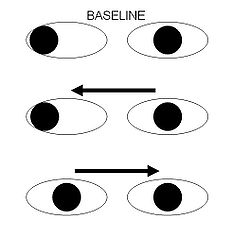
One and a half syndrome
Encyclopedia

Syndrome
In medicine and psychology, a syndrome is the association of several clinically recognizable features, signs , symptoms , phenomena or characteristics that often occur together, so that the presence of one or more features alerts the physician to the possible presence of the others...
is a rare ophthalmoparetic
Ophthalmoparesis
Ophthalmoparesis or ophthalmoplegia refers to paralysis of one or more extraocular muscles which are responsible for eye movements. It is a physical finding in certain neurologic illnesses.-Classification:...
syndrome
Syndrome
In medicine and psychology, a syndrome is the association of several clinically recognizable features, signs , symptoms , phenomena or characteristics that often occur together, so that the presence of one or more features alerts the physician to the possible presence of the others...
characterized by "a conjugate horizontal gaze palsy in one direction and an internuclear ophthalmoplegia
Internuclear ophthalmoplegia
Internuclear ophthalmoplegia is a disorder of conjugate lateral gaze in which the affected eye shows impairment of adduction. When an attempt is made to gaze contralaterally , the affected eye adducts minimally, if at all. The contralateral eye abducts, however with nystagmus...
in the other". The most common manifestation of this unusual syndrome is limitation of horizontal eye movement to adduction (moving away from the midline) of one eye (e.g. right eye in the diagram on the right) with no horizontal movement of the other eye (e.g. left eye in the diagram on the right). Nystagmus
Nystagmus
Nystagmus is a condition of involuntary eye movement, acquired in infancy or later in life, that may result in reduced or limited vision.There are two key forms of Nystagmus: pathological and physiological, with variations within each type. Nystagmus may be caused by congenital disorders,...
is also present when the eye on the opposite side of the lesion is abducted. Convergence is classically spared as Cranial Nerve III (oculomotor nerve) and its nucleus is spared bilaterally.
Anatomy
The syndrome usually results from single unilateral lesion of the paramedian pontine reticular formationParamedian pontine reticular formation
The paramedian pontine reticular formation, or PPRF, is part of the pontine reticular formation, a brain region without clearly defined borders in the center of the pons. It is involved in the coordination of eye movements, particularly horizontal gaze and saccades.- Input, Output, and Function...
and the ipsilateral medial longitudinal fasciculus
Medial longitudinal fasciculus
The medial longitudinal fasciculus is a pair of crossed fiber tracts , one on each side of the brainstem. These bundles of axons are situated near the midline of the brainstem and are composed of both ascending and descending fibers that arise from a number of sources and terminate in different...
. An alternative anatomical cause is a lesion of the abducens nucleus (VI) on one side, with interruption of the ipsilateral medial longitudinal fasciculus
Medial longitudinal fasciculus
The medial longitudinal fasciculus is a pair of crossed fiber tracts , one on each side of the brainstem. These bundles of axons are situated near the midline of the brainstem and are composed of both ascending and descending fibers that arise from a number of sources and terminate in different...
after it has crossed the midline from its site of origin in the contralateral oculomotorius (III) nucleus (resulting in a failure of adduction of the ipsilateral eye).
Causes
Causes of the one and a half syndrome include pontine hemorrhage, ischemiaStroke
A stroke, previously known medically as a cerebrovascular accident , is the rapidly developing loss of brain function due to disturbance in the blood supply to the brain. This can be due to ischemia caused by blockage , or a hemorrhage...
, tumors
Cancer
Cancer , known medically as a malignant neoplasm, is a large group of different diseases, all involving unregulated cell growth. In cancer, cells divide and grow uncontrollably, forming malignant tumors, and invade nearby parts of the body. The cancer may also spread to more distant parts of the...
, infective mass lesions such as tuberculomas
Tuberculosis
Tuberculosis, MTB, or TB is a common, and in many cases lethal, infectious disease caused by various strains of mycobacteria, usually Mycobacterium tuberculosis. Tuberculosis usually attacks the lungs but can also affect other parts of the body...
, and demyelinating conditions like multiple sclerosis
Multiple sclerosis
Multiple sclerosis is an inflammatory disease in which the fatty myelin sheaths around the axons of the brain and spinal cord are damaged, leading to demyelination and scarring as well as a broad spectrum of signs and symptoms...
.
Treatment
There have been cases of improvement in extra-ocular movement with botulinum toxinBotulinum toxin
Botulinum toxin is a protein produced by the bacterium Clostridium botulinum, and is considered the most powerful neurotoxin ever discovered. Botulinum toxin causes Botulism poisoning, a serious and life-threatening illness in humans and animals...
injection.
External links
- This link incorrectly states that the contralateral eye can still adduct. It can only abduct with nystagmus.- Video at University of UtahUniversity of UtahThe University of Utah, also known as the U or the U of U, is a public, coeducational research university in Salt Lake City, Utah, United States. The university was established in 1850 as the University of Deseret by the General Assembly of the provisional State of Deseret, making it Utah's oldest...

